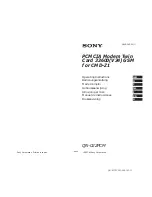
9XTendNEMA™
RS
‐
232/485
RF
Modem
–
Product
Manual
v2.x4x
[2007.01.04]
©
2007
MaxStream,
Inc.,
Confidential
&
Proprietary
‐
All
Rights
Reserved
54
5.2.3. Repeater Mode
Attributes:
Low power consumption
Minimized interference
Each RF packet is tagged with a unique Packet ID (PID).
Each repeater will repeat a packet only once (tracked by the PID).
Increased latency and decreased throughput
(Latency and throughput is determined by number of hops, not by number of
repeaters. Multiple repeaters within range of source node count as one hop.)
All RF packets propagate to every modem in the network (filtering rules apply).
Packet destination addresses (DT) determine which packets are sent out serial
port and/or retransmitted.
Broadcast communications - each packet comes out every node exactly once.
Addressed communications - all modems see every packet. Only the modem
with a matching address will forward it to the DO buffer (UART IN).
Constraints:
Requires that each modem have a unique MY (Source Address) parameter.
System must introduce just one packet at a time to the network for transmission
(Maximum number of bytes is determined by the PK parameter).
Each hop (H) decreases network throughput by a factor of 1/(H+1). Additional
repeaters add network redundancy without decreasing throughput.
Suggestions:
Insert a variable delay before repeating packets to avoid collisions
(based on RSSI).
Buffer any incoming serial data and delay response packet transmissions until
previous packet has cleared out of network.
For best results, use the RO and RB commands to ensure that the RF packets
align with the underlying protocol packets as the network can only accept one RF
packet at a time.
Required Parameter Values (TX modem): MD = 5 or 6, MY = unique value (can be accom-
plished by issuing the AM (Auto-set MY) and WR (Write) commands to all modems in the network)
Related Commands: Networking (MD, DT, MY, AM), Serial Interfacing (RN, PK, RO, RB)
Recommended Use: Use in networks where intermediary modems are needed to relay data to
modems beyond the transmission range of the base modem.
Theory of Operation
OEMs and integrators can extend the effective range and reliability of their data radio system by
forwarding traffic through one or more repeaters. Instead of using routing tables and path discov-
ery to establish dynamic paths through a network, the repeater system uses a sophisticated algo-
rithm to propagate each RF packet through the entire network.
The network supports RF packets up to 2048 bytes (when the RF data rate is set at 9600 bps (BR
= 0)). The repeater network can operate using broadcast or addressed communications for multi-
drop networks and works well in many systems with no special configuration.
When in Repeater Mode, the network repeats each message among all available modems exactly
one time. This mechanism eliminates the need for configuring specific routes.
Figure
5
‐
06. Repeater
Network
Topology













































